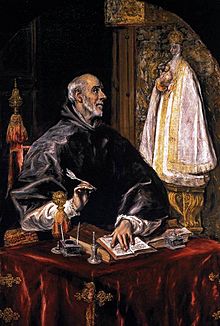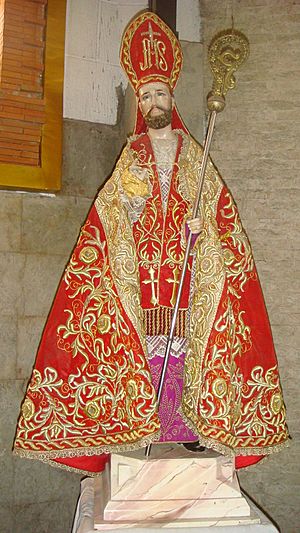Ildefonsus facts for kids
Quick facts for kids SaintIldephonsus of Toledo |
|
|---|---|

|
|
| Bishop of Toledo | |
| Born | 8 December 607 |
| Died | 23 January 667 |
| Venerated in | Roman Catholic Church Eastern Orthodox Church |
| Feast | 23 January |
Saint Ildefonsus (born around 8 December 607, died 23 January 667) was an important scholar and religious leader. He served as the Bishop of Toledo in Spain for the last ten years of his life. His original name was Hildefuns. In some churches, like the Ethiopian Orthodox Tewahedo Church, he is known as Dexius.
Even though his writings were not widely known outside of Spain, Ildefonsus became a saint. He remained a very important figure in the Iberian Peninsula (Spain and Portugal) for many centuries. Spanish and Portuguese missionaries helped spread his ideas around the world.
Contents
Life of Saint Ildefonsus
Ildefonsus was born into a well-known Visigothic family in Toledo, Spain. This was during a time when there were many civil wars in the Visigothic kingdom. His uncle, Eugenius, who later became the Bishop of Toledo, started teaching him about religion.
Around the year 632, Ildefonsus began his religious journey. He became a deacon, which is a church official, under Bishop Eladius of Toledo. However, Ildefonsus chose a different path than his family planned. He decided to become a monk at the Agali monastery outside the city. While there, he also helped start a monastery for nuns.
In 650, Ildefonsus was chosen to be the abbot, or leader, of the Agali monastery. In this role, he attended two important meetings of the church in Spain. These were the eighth and ninth Councils of Toledo. When his uncle Bishop Eugenius II died in 657, Ildefonsus was chosen to take his place as bishop. King Recceswinth made him accept the job, even though Ildefonsus later said he didn't want it.
Amazing Stories and Visions
Later, in the late 700s, a church leader named Cixila added more details to Ildefonsus's life story. He wrote that one day, Ildefonsus was praying in front of the remains of Leocadia, a saint. Suddenly, Saint Leocadia rose from her tomb and thanked him for his strong devotion to the Mother of God.
Another famous story says that on 18 December 665, Ildefonsus had a special vision. The Blessed Virgin Mary herself appeared to him. She gave him a special priestly robe, called a chasuble, to reward him for honoring her so much. As Bishop Ildefonsus and the people in the church sang hymns to Mary, a bright light filled the church. Most of the people ran away, but Ildefonsus stayed with a few deacons. He saw Mary come down and sit on the bishop's chair. She praised Ildefonsus for his dedication. She told him to wear the special robe only during festivals honoring Mary. Because of this vision, Toledo's church later gained more importance in Spain.
Death and Lasting Impact
Ildefonsus died after serving as bishop for ten years. He was buried in Toledo at the Church of Santa Leocadia. After his death, another church council decided that 18 December would be a special day to celebrate Mary. This was to remember Ildefonsus's vision.
Even when Muslims later ruled Spain and the church became a mosque, the spot where the vision happened remained sacred to the Virgin Mary. People traveled to Toledo to see the stone where Mary was said to have stood. During later wars, Ildefonsus's remains were moved to Zamora. They are still kept there today at the Church of Sts. Peter and Ildefonso.
Ildefonsus is considered a patron saint of Toledo and Zamora, as well as several smaller towns. His feast day is 23 January, which is the day he died. In a town called Olula del Río, people celebrate with bonfires and fireworks the night before. They also have a traditional parade where they toss bread to people watching.
Spanish missionaries helped spread the devotion to Saint Ildefonsus around the world. Places named after him include the San Ildefonso Peninsula and towns like San Ildefonso, Bulacan and San Ildefonso, Ilocos Sur in the Philippines. There are also towns named after him in Guatemala and El Salvador, and San Ildefonso Pueblo, New Mexico in the United States.
His Writings and Beliefs

Ildefonsus wrote many important works about Christian beliefs. His most famous book was De perpetua virginitate Mariae contra tres infideles. This book was about Mary's lasting virginity and became central to Spanish beliefs about Mary. He used a special writing style where he repeated ideas in different ways to make his points stronger.
Ildefonsus also likely wrote parts of the Visigothic Mass for the Ascension. This explains how the good things we receive from Christ are even greater than the miracles he performed. He believed that the Nicene Creed (a statement of Christian faith) gave enough knowledge for salvation. He also saw it as a special agreement between a believer and God. Like Isidore of Seville before him, Ildefonsus thought the creed created two promises: one to reject evil, and another to state one's belief.
Ildefonsus encouraged people to take Holy Communion often. This suggests that at the time, people didn't receive it very frequently. He also stressed the importance of being prepared for it.
His book De viris illustribus continued a work by Isidore. It added biographies of important church leaders and government officials from Toledo. This book became a key historical source for the 6th and 7th centuries in Toledo. Ildefonsus also put together a collection of Isidore's works.
In his book De cognitione baptismi, Ildefonsus explained the origins of baptism in the Bible. He also described baptism practices in Spain and important prayers. He wrote another book, De progressu spiritualis deserti, which compared baptism to the Israelites crossing the Red Sea. He saw it as the start of a personal spiritual journey.
Some of Ildefonsus's letters to Quiricus of Barcelona still exist. He also wrote two other works that are now lost. One was about his own weaknesses, and the other discussed a religious idea called monothelitism.
His work Libellus de Corona Virginis has recently been translated into English. It is now called Crown of the Virgin: An Ancient Meditation on Mary's Beauty, Virtue, and Sanctity.
See also
 In Spanish: Ildefonso de Toledo para niños
In Spanish: Ildefonso de Toledo para niños
- Saint Ildefonsus, patron saint archive

